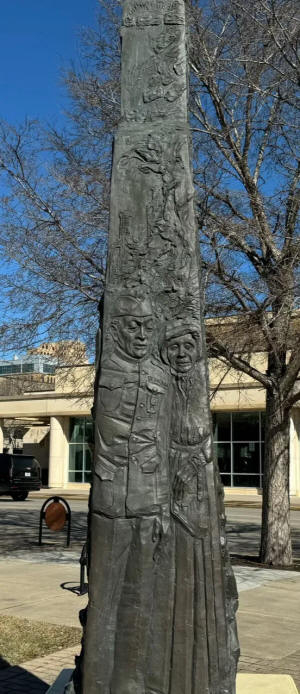Forgotten Black military heroes featured in Illinois State Museum
exhibit
[March 01, 2025]
By Leonardo Pini, Athan Yanos
SPRINGFIELD – As Black History Month comes to an end, the Illinois State
Museum this week honored Black Springfield residents who excelled in
their military service to the country – from forgotten heroes of the
Civil War to soldiers deployed in France during World War I who earned
the nickname “Black Devils” from the Germans.
The event was one in a series dedicated to the Black community of
Springfield, organized in a partnership with the Illinois Department of
Natural Resources, the Illinois State Museum, Springfield’s local public
Lincoln Library, the Illinois State Military Museum and Fever River
Research.
It capped a variety of tributes during Black History Month and
historical talks, hikes, films and tours put on by Springfield state
historic sites to showcase the lives and accomplishments of
Springfield’s Black residents.
“The main takeaway we want people to walk away with is that Black
excellence in terms of military service has been tied before and during
and after the Civil War to the struggle for freedom and citizenship,”
said Sheila Ryan, a researcher who works at the Illinois Department of
Natural Resources and helped organize an event Wednesday in their honor.
Springfield has a deep history in the Civil Rights movement. The city’s
brutal 1908 race riots were a principal catalyst for the establishment
of the National Association for The Advancement of Colored People, or
NAACP.
The Springfield race riots were spurred by an angry mob looking to lynch
a pair of Black men in the Sangamon County Jail, who were being held on
unrelated charges of murder and rape – though the alleged rape victim, a
white woman, would later recant her story. Officials nervous about the
mob orchestrated a false fire to distract the crowd to move the men from
the jail, which further angered the mob leading to an all-out riot that
ultimately lynched two other Black men and killed more than a dozen
others involved.
The mob burned down much of Springfield’s poorer Black neighborhood and
destroyed dozens of Black-owned businesses in the city’s wealthier
mostly Black neighborhood.
In 2019, archaeological mitigation efforts for the Springfield Rail
Improvements Project found that some of those homes in the neighborhood
that burned down during the riots, then known as the Badlands, belonged
to some of the Black military men who excelled and were celebrated
during this month’s exhibit at the Illinois State Museum.
That included Silas Sappington, who was a member of the 55th
Massachusetts Infantry Regiment – an all-Black regiment with white
officers that served during the Civil War, according to Adam Krall, who
also helped organize the event and is a historic site interpreter with
the Illinois Department of Natural Resources.

The exhibit also features Otis Duncan, who helped put down the 1908 race
riots and in the process had his family home attacked and ransacked,
destroying a portrait of his mother. Duncan at the time served in the
8th Infantry Regiment of the Illinois National Guard, which later became
the 370th Infantry Regiment, an all-Black regiment.
As its colonel, Duncan went on to lead the regiment, which served
alongside the French during the First World War.
[to top of second column]
|

A sculpture outside of the Abraham Lincoln Presidential Library and
Museum in downtown Springfield commemorating the city’s 1908 race
riots. The sculpture features Lt. Col. Otis Duncan, whose family
home was attacked during the riots and who later led the heavily
decorated all-Black 370th Infantry Regiment who served alongside the
French during the First World War. (Medill Illinois News Bureau
photo by Athan Yanos)

“ The French called them partridges, which is a mark of honor and
distinction because these men go into battle very proudly and very
bravely,” Krall said. “The Germans gave them a nickname – the ‘Black
Devils’ – because they feared these men. When they attacked, they didn’t
stop.”
As a result of their actions in the war, soldiers of the 370th Infantry
Regiment received 21 Distinguished Service Crosses from the United
States and 68 Croix de Guerre from France, an honor awarded to soldiers
for bravery in combat.
Despite their military accomplishments, the Black soldiers returned home
to a society that didn’t treat them as equals. Krall noted that
Springfield’s Oak Ridge Cemetery, which features President Abraham
Lincoln’s tomb, also has 28 Black Civil War soldiers buried there.
“Their service and their graves have been essentially forgotten, or it
was not convenient to talk about it,” Krall said. “To bring this to fore
is something really important for us as historical interpreters.
Among the attendees at Wednesday’s event, Eric Sanchez, a veteran
deployed in Iraq and a resident of Quincy, Illinois, said he drove two
hours each way to see the exhibit and learn more about soldiers who have
made the same sacrifice he has.
“When you are a soldier, you want to come home to a grateful
population,” Sanchez said. “I love history, and I wanted to see what it
was like to be a Black soldier in the 1900s, when many Black people were
still treated like criminals in society.”
Athan Yanos and Leonardo Pini are graduate students
in journalism with Northwestern University’s Medill School of
Journalism, Media, Integrated Marketing Communications, and a Fellow
in its Medill Illinois News Bureau working in partnership with
Capitol News Illinois.
Capitol News Illinois is
a nonprofit, nonpartisan news service that distributes state
government coverage to hundreds of news outlets statewide. It is
funded primarily by the Illinois Press Foundation and the Robert R.
McCormick Foundation. |